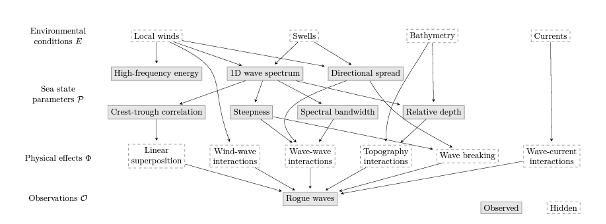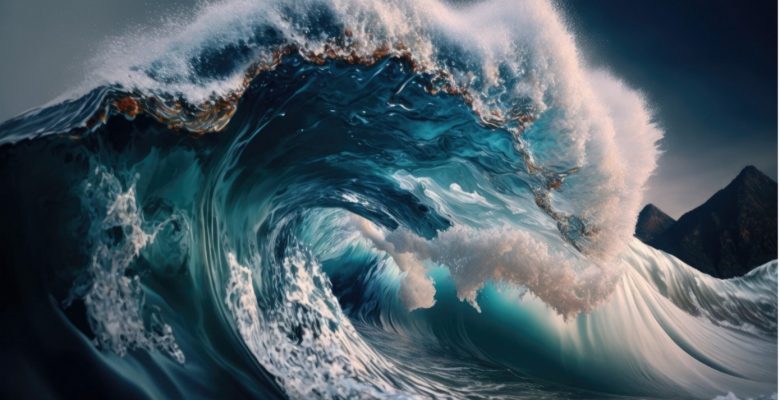Faced with the risk posed by rogue waves on the high seas, researchers used AI to analyze centuries of ocean data, resulting in an algorithm capable of predicting these phenomena. This new tool is crucial for navigation since it allows maritime routes to be adjusted according to identified risks and marks significant progress in the prevention of maritime dangers.
By Laurie Henry
Rogue waves deciphered using historical data
Rogue waves, these unpredictable and feared maritime phenomena, have long defied scientific understanding. Historically considered rare and dangerous ocean anomalies, they represent a significant risk to maritime navigation. They are notable for their gigantic size, often twice the size of ordinary waves, and can occur without warning, making navigation on the high seas particularly risky. Understanding the mechanisms that generate them is therefore of capital importance for maritime security.
Recently, a collaboration between the University of Copenhagen and the University of Victoria led to a breakthrough in predicting these waves (Dion Häfner, et al., 2023). Their research effort is remarkable both for its breadth and its depth. By looking at more than a billion waves, these scientists were able to access a time window covering 700 years of ocean activity. This allows waves to be observed under many climate cycles and weather conditions, providing a comprehensive perspective on their behavior through ages.
This data was collected using a network of buoys positioned in 158 strategic locations around the world. Each buoy played the role of a silent observer continuously, 24 hours a day, tirelessly recording detailed information about the waves, such as their height, periodicity, and force.
A methodological revolution thanks to artificial intelligence
The application of artificial intelligence (AI) in ocean data analysis has marked a turning point in rogue wave research. Indeed, faced with the immensity and complexity of the data collected, AI is a powerful and essential tool. The main objective was to transform this vast and heterogeneous raw data into a reliable and precise predictive model.
The authors explain in a press release that they relied on advanced machine learning methods, in particular symbolic regression. This technique stands out for its ability to generate explicit mathematical models from data. Unlike traditional machine learning approaches, which often focus on prediction without providing a clear understanding of the underlying relationships, symbolic regression creates equations that reflect the causal relationships between variables. In the context of this study, this means identifying how different oceanographic factors interact to form a rogue wave.
The advantage of this approach is twofold. On the one hand, it allows researchers to understand not only that certain conditions can lead to the formation of rogue waves, but also how and why these interactions occur. On the other hand, the equations generated by symbolic regression can be used to predict the appearance of these waves. This represents a major advance compared to previous methods, which were mainly based on empirical observations and experiments.
A new look at the formation of rogue waves
Previously, researchers believed that these giant waves were mainly the result of an energy accumulation process, when a wave gradually absorbs energy from adjacent waves and grows significantly in size and power. However, the results of this research indicate that the phenomenon of linear superposition plays a much more crucial role in the genesis of these monstrous waves.

The causes of rogue waves as a causal DAG (directed acyclic graph). The arrows A → B imply that A causes B. © Dion Häfner, et al., 2023
Linear superposition is a physical concept that occurs when two or more waves intersect and add together. In the context of ocean waves, this means that when two distinct wave systems meet, their crests and troughs can align in such a way that they add up. This conjunction can result in the sudden formation of a wave whose height is significantly greater than that of the individual component waves.
This discovery is significant because it changes our understanding of ocean dynamics. It suggests that the conditions necessary for the formation of rogue waves could be more frequent and less exceptional than previously believed. Indeed, linear superposition is a relatively common phenomenon in the oceans, where multiple wave systems regularly intersect.
Towards safer navigation
This new perspective on rogue wave formation has important implications for marine weather forecasting and maritime safety. It says areas and conditions conducive to linear superposition should be closely monitored, as they could signal an increased risk of rogue waves.
In addition, this new tool developed by the authors is a considerable asset for shipping companies. Indeed, until now, captains and route planners had to rely primarily on general weather forecasts and their experience to navigate safely. With the introduction of this algorithm, they now have a specific tool that can signal the risk of rogue waves in real time. Additionally, this technology could be integrated into automated navigation systems, allowing ships to change their trajectory in real time in response to the algorithm’s predictions.

A ship grappling with a rogue wave. © John Lund/Getty
Beyond commercial shipping, this tool also has implications for offshore search activities, rescue operations and military missions, for which understanding maritime conditions is essential. By anticipating rogue waves, crews can take preventative measures to secure equipment and prepare for extreme maritime conditions.
Source : Dion Häfner, et al., “Machine-guided discovery of a real-world rogue wave model”, PNAS, Vol. 120 | No. 48, 2023
